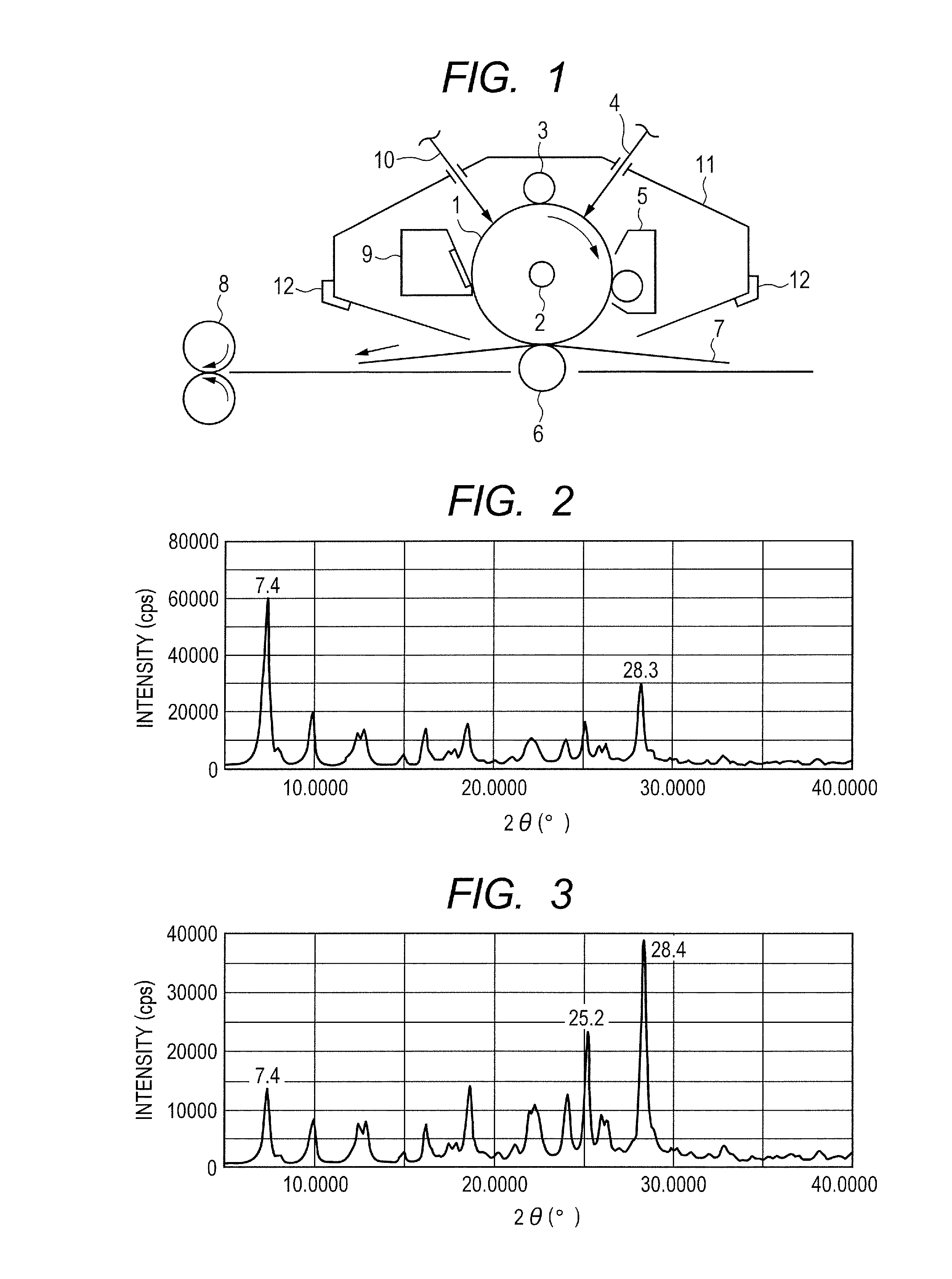Electrophotographic photosensitive member, process cartridge and electrophotographic apparatus
a photosensitive member and electrophotography technology, applied in the direction of electrographic process, instrument, corona discharge, etc., can solve problems such as potential variation, and achieve the effect of reducing image defects
- Summary
- Abstract
- Description
- Claims
- Application Information
AI Technical Summary
Benefits of technology
Problems solved by technology
Method used
Image
Examples
example 1-1
[0095]Hydroxygallium phthalocyanine was prepared by the same treatment as in the synthesis example 1 and the subsequent example 1-1 described in Japanese Patent Application Laid-Open No. 2011-94101. Then, 0.5 parts of the hydroxygallium phthalocyanine, 1.0 part of the exemplary compound (1) (product code: 159400050, made by Acros Organics), and 10 parts of N,N-dimethylformamide were put in a ball mill with 20 parts of glass beads having a diameter of 0.8 mm so as to be milled at room temperature (23° C.) for 40 hours. A gallium phthalocyanine crystal was produced from the dispersion liquid using N,N-dimethylformamide. In filtration, the strainer was sufficiently cleaned with tetrahydrofuran. The filter residue was vacuum dried so that 0.50 parts of hydroxygallium phthalocyanine crystal was obtained. The powder X-ray diffraction chart of the produced hydroxygallium phthalocyanine crystal is illustrated in FIG. 2.
[0096]By NMR measurement, it was confirmed based on the conversion from ...
example 1-2
[0097]In Example 1-1, 1.0 part of the exemplary compound (1) was replaced with 0.5 parts of the exemplary compound (2) (product code: B0139, made by Tokyo Chemical Industry Co., Ltd.), and the milling treatment time was changed from 40 hours to 55 hours. 0.46 parts of hydroxygallium phthalocyanine crystal was obtained by the same treatment as in Example 1-1 except for the above. The powder X-ray diffraction chart of the produced crystal is illustrated in FIG. 3.
[0098]By NMR measurement, it was confirmed based on the conversion from proton ratio that 0.16% by mass of the exemplary compound (2) and 1.88% by mass of N,N-dimethylformamide were contained in the hydroxygallium phthalocyanine crystal. Since the exemplary compound (2) is soluble in N,N-dimethylformamide, it was found that the exemplary compound (2) was contained in the crystal.
example 1-3
[0099]1.0 part of the exemplary compound (1) in Example 1-1 was replaced with 1.0 part of the exemplary compound (4) (product code: B1433, made by Tokyo Chemical Industry Co., Ltd.). 0.50 parts of hydroxygallium phthalocyanine crystal was obtained by the same treatment as in Example 1-1 except for the above. The powder X-ray diffraction chart of the produced hydroxygallium phthalocyanine crystal was the same as in FIG. 2.
[0100]By NMR measurement, it was confirmed that based on the conversion from proton ratio 0.28% by mass of the exemplary compound (4) and 2.14% by mass of N,N-dimethylformamide were contained in the phthalocyanine crystal. Since the exemplary compound (4) is soluble in N,N-dimethylformamide, it was found that the exemplary compound (4) was contained in the crystal.
PUM
| Property | Measurement | Unit |
|---|---|---|
| Bragg angles 2θ | aaaaa | aaaaa |
| Bragg angles 2θ | aaaaa | aaaaa |
| wavelength range | aaaaa | aaaaa |
Abstract
Description
Claims
Application Information
 Login to View More
Login to View More - R&D
- Intellectual Property
- Life Sciences
- Materials
- Tech Scout
- Unparalleled Data Quality
- Higher Quality Content
- 60% Fewer Hallucinations
Browse by: Latest US Patents, China's latest patents, Technical Efficacy Thesaurus, Application Domain, Technology Topic, Popular Technical Reports.
© 2025 PatSnap. All rights reserved.Legal|Privacy policy|Modern Slavery Act Transparency Statement|Sitemap|About US| Contact US: help@patsnap.com



